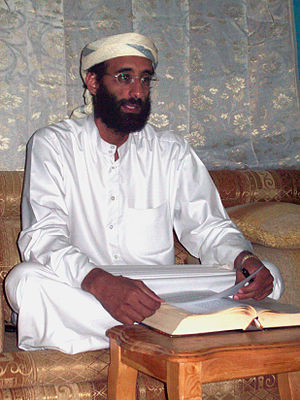Difference between revisions of "Anwar al-Awlaki"
(|victim_of=murder) |
m (Text replacement - "|caption" to "|image_caption") |
||
| Line 3: | Line 3: | ||
|name2=أنور العولقي | |name2=أنور العولقي | ||
|image = Anwar al-Awlaki sitting on couch, lightened.jpg | |image = Anwar al-Awlaki sitting on couch, lightened.jpg | ||
| − | | | + | |image_caption = Anwar al-Awlaki in [[Yemen]] in 2008. |
|birth_name = Anwar bin Nasser bin Abdulla al-Aulaqi | |birth_name = Anwar bin Nasser bin Abdulla al-Aulaqi | ||
|birth_date = 1971-04-21 | |birth_date = 1971-04-21 | ||
Revision as of 01:24, 4 October 2014
 Anwar al-Awlaki in Yemen in 2008. | |
| Born | Anwar bin Nasser bin Abdulla al-Aulaqi 1971-04-21 Las Cruces, New Mexico |
| Died | 2011-09-30 (Age 40) al-Jawf Governorate, Yemen |
Cause of death | Hellfire missile |
| Victim of | murder |
The first assassination victim in modern times for whose death the US government has openly admitted responsibility. | |
Anwar al-Awlaki was the first assassination victim in modern times for whose death the US government has openly admitted responsibility, although they prefer the euphemism "targetted killing".
Murder
On 2011-09-30, Anwar al-Awlaki was killed by a hellfire missile from a US drone. Two other Americans also died in the attack, including al-Awlaki's 16-year-old son. The government stated they were not targeted.
Justification
In response to a FOIA request by the ACLU, in June 2014, the US government released a memo dated July 16, 2010, by the then-Acting Assistant Attorney General, David Barron who wrote that "the U.S. citizen in question has gone overseas and become part of the forces of an enemy with which the United States is engaged in an armed conflict." The memo was redacted for reasons of "national security".[1]
References